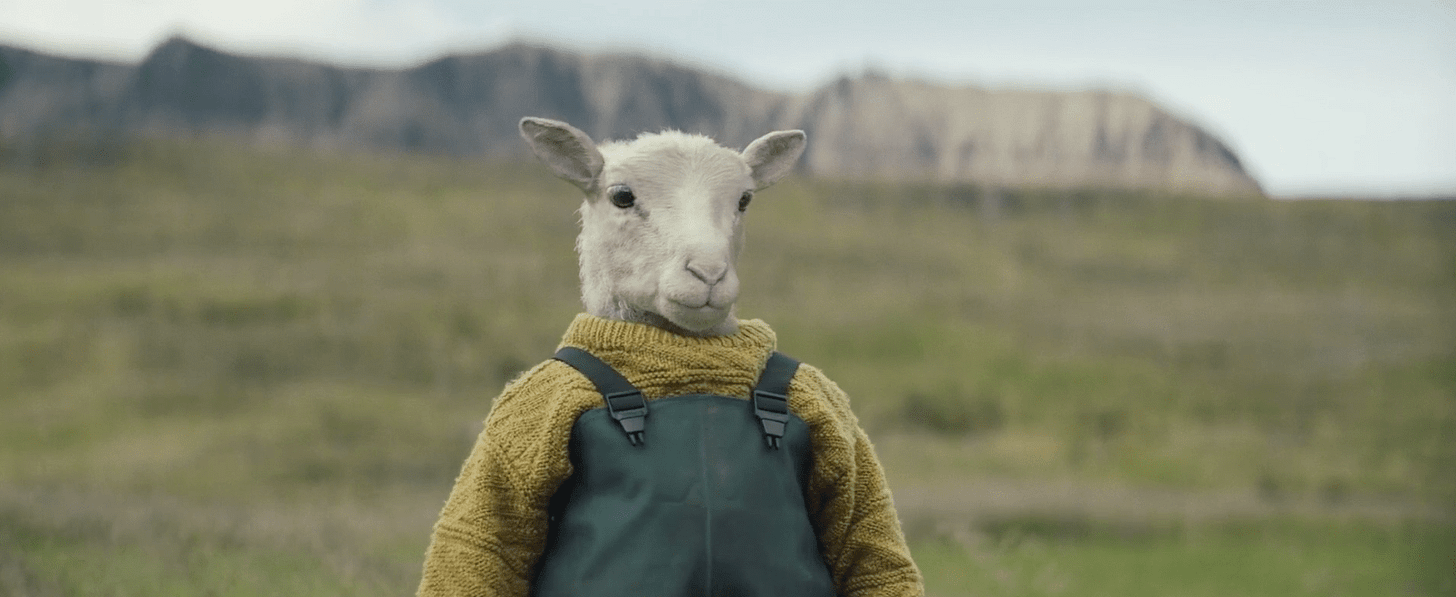In this issue: Lamb (2021, 106 minutes, available on Showtime and to rent, which frankly I doubt anyone has)
Lamb (2021) is a perfectly fine movie. It was hampered by a bad trailer that inexplicably used the Beach Boys and made it seem more like the ““elevated horror”” that A24 trots out every quarter. But Lamb is more of a family drama, tinged with myth and fairytale, and contains a rare delight—a creature irresistibly, unbearably, Paddington-level cute. I’ve been sitting on this letter for a while, but after video game auteur Hideo Kojima started tweeting pictures of his own Lamb doll, I decided it was time to come clean.
Ada is the little lamb born in the sheep barn of an isolated Icelandic couple, María (Noomi Rapace) and Ingvar (Hilmir Snær Guðnason). As the film unravels it becomes clear that the couple is dealing with some severely unprocessed grief, and that Ada is a spark in their otherwise deeply melancholy lives. Throughout the movie I wondered how Ada would appear to outsiders—are the couple so desperate for a child they will put their livestock in pinafores and overalls, or is she just as human as she appears? How much of the unconditional love they have for Ada is projection of their own loneliness? (This is something I, a cat-owner, wonder all the time.)
Ada is rendered through a mix of CGI, composite shots with child and animal actors, and puppetry. The result is not seamless but the effect is transfixing. Although it takes a while before we see exactly what she looks like, it’s immediately clear that she is not a normal lamb, something between sheep and human. Ada tugged at my (very) faint maternal heartstrings. Her dewy, curious eyes, her blush-pink nose, her fluttering ears. Her entrance immediately brings laughter and music to a previously silent and miserable household. And I get it. When I was spending 2020 and 2021 in near-total isolation, I would’ve given anything for an Ada.
Her sudden arrival is an inversion of the changeling myth. The changeling is a figure throughout European folklore: a child stolen and replaced by a doppelgänger born of otherworldly creatures. This myth is often associated with Ireland and the British Isles, but this Icelandic folktale, where an elf woman returns to fetch her changeling husband, is illuminative to Ada’s story. There are also tales about the magical livestock of the elves, which resemble normal livestock but produce superior wool or meat. Interfering with an elf’s livestock without permission was a dangerous and often fatal mistake. And key to Ada’s story is that she is not given to the couple. They take her.
And rather than be disgusted by her strange appearance, they fall in love with her immediately and make her a permanent part of their household. That love makes her presence all the more dangerous. The changeling myth (and similar myths about domestic animal/human hybrids like swan maidens and selkies) does not generally end with the creature living harmoniously with their new family and the fear of what will happen to Ada undergirds the story. Will these two people really raise Ada into adulthood—is that even possible? What kind of life is available for her? How conscious is she of who, or what, she is?
I suppose these fears live in the heads of all parents, in some way, especially those who have dealt with child death. Most parents believe their children are special but it’s hard not to see Ada as somewhat divine: lamb of God, mysterious birth, mother named María, etc. etc. That mystery is somewhat disrupted by the ending, which (no spoilers) is quite literal.
What I appreciate about Lamb is how seriously it takes the brutality of the landscape. There is no pre-packaged whimsy—perhaps the movie would have done better if it had more in common with the cottagecore aesthetic and could’ve ridden on A24’s standard social media wave. Instead, the limited charm of the couple’s country life feels like beauty they have deliberately spun.
Iceland does not have apex predators. The most dangerous elements on the island are man and its landscape. In their tidily ordered farmhouse, surrounded by sheep, cats, and miles of empty plain, María and Ingvar incorrectly but unsurprisingly believe they’re in control. Lamb is a reminder of how scarce and precious life is, how tenuous our dominion of the land is. These are familiar anxieties even if you do not live on a rural homestead. The couple’s grief and sadness are similarly recognizable, their ongoing emotional crisis reminiscent of the last three years we’ve spent dealing and not dealing with mass death. And Ada provides their tangible purpose, something to love and care for, a reminder of the joy and beauty that can suddenly exist alongside unrelenting entropy.








“Lambily” 😍
Thank you for this perspective. I did see the trailer and wondered if I could handle what seemed to be a horror movie that would likely involve mutilated livestock. Sounds like there’s still a possibility of blood but your review has me interested. I’ll check it out. Thanks.